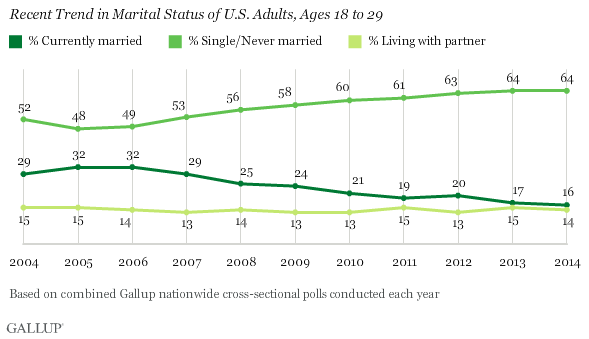PRINCETON, N.J. -- Along with the decline in marriages among 18- to 29-year-olds in the U.S. in recent years, Gallup trends on Americans' living arrangements reveal that the percentage of young adults "living together" has hardly budged. This means that not only are fewer young adults married, but also that fewer are in committed relationships. As a result, the percentage of young adults who report being single and not living with someone has risen dramatically in the past decade, from 52% in 2004 to 64% in 2014.

30-Somethings Gravitating Toward Unmarried Partnerships
Marriage remains the dominant living arrangement for people in their 30s. However, in contrast to the sharp rise in the percentage of 20-somethings leading a single lifestyle, 30-somethings were only slightly more likely to be single in 2014 compared with a decade earlier. This is because, while the percentage of 30-somethings who are married has declined about 10 percentage points, the percentage living together has increased significantly -- nearly doubling from 7% to 13%.

Meanwhile, the living arrangements of adults aged 40 and older are largely unchanged. For the past decade, approximately six in 10 reported being married, between 7% and 8% reported being single/never married, and between 3% and 5% reported living together.
These findings are based on yearly aggregates of Gallup's nationwide cross-sectional surveys, encompassing between 15,000 and 32,000 interviews each year.
Broad-Based Increase in Single 20-Somethings
The increase in 18- to 29-year-olds identifying as single and never married is seen across a broad range of subgroups, including by race, education, region and political party.
Still, young Southerners are slightly less likely than their counterparts in other regions to be single, and young whites and Hispanics are less likely to be single than young blacks. Additionally, fewer young women than young men are single, suggesting many women in their 20s are married to men 30 or older. And college graduates are less likely to be single than those with only some or no college education.

Bottom Line
It is widely known that fewer young people today are getting married. But Gallup's data reveal that young adults are not simply swapping marriage for living together, but rather staying single longer. This doesn't necessarily mean young adults are staying out of relationships, just that they are less likely to be making the more serious commitment associated with moving in together -- whether in marriage or not. It also doesn't mean they are completely independent. In 2013, Gallup found 14% of adults aged 24 to 34 were living under a parent's roof.
This rise of singledom is particularly evident with 18- to 29-year-olds, increasing by roughly a quarter since 2004, from 52% to 64%. But it is also evident among adults aged 30 to 39, creeping up from 15% to 19% over the same period.
The important question for society is whether the dramatic shift in living arrangements seen among 20-somethings persists into their 30s, furthering the revolution in U.S. household and family structure. At least attitudinally, Gallup recently found adults in the 18- to 34-year-old age bracket expressing nearly as much desire as older adults to be married, even as they themselves were far less likely to be married currently. But whether that desire among these younger Americans materializes in the coming years remains to be seen.
The data in this article are available in Gallup Analytics.
Survey Methods
Results are based on yearly aggregated data from Gallup Poll Social Series surveys and other multiple-day cross-sectional telephone polls conducted between 2004 and 2014. Each yearly aggregate is based on a minimum of 15,000 interviews with adults, aged 18 and older, and as many as nearly 32,000 interviews. These include interviews with between 1,340 and 3,616 adults aged 18 to 29, and 1,788 to 4,733 adults aged 30 to 49.
For results based on the total sample of national adults in any given year, the maximum margin of sampling error is ±1 percentage point at the 95% confidence level.
For results based on the total sample of Americans ages 18 to 29 or 30 to 39 in any given year, the maximum margin of sampling error is ±3 percentage points at the 95% confidence level.
Gallup measures marital status by asking respondents, "Which of the following best describes your marital status: currently married, living together with a partner, widowed, divorced, separated or never married?"
Learn more about how Gallup Poll Social Series works.
